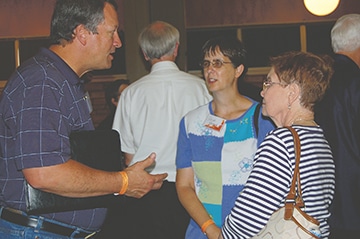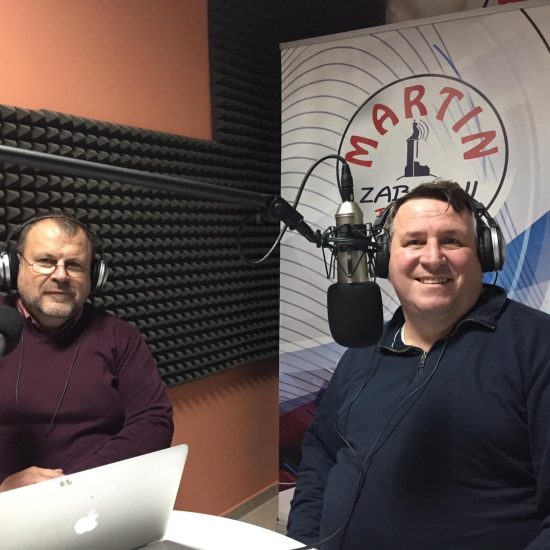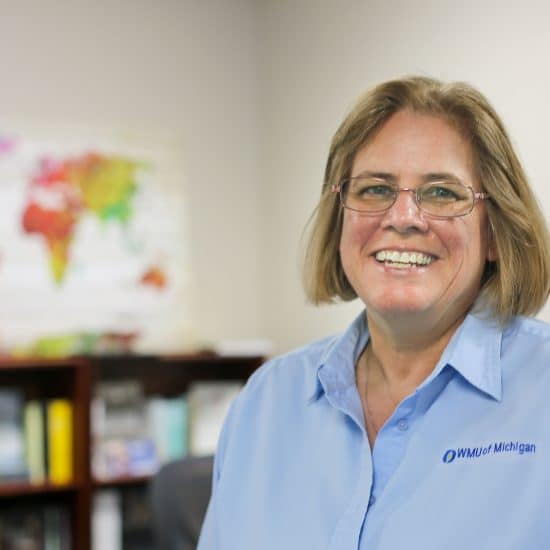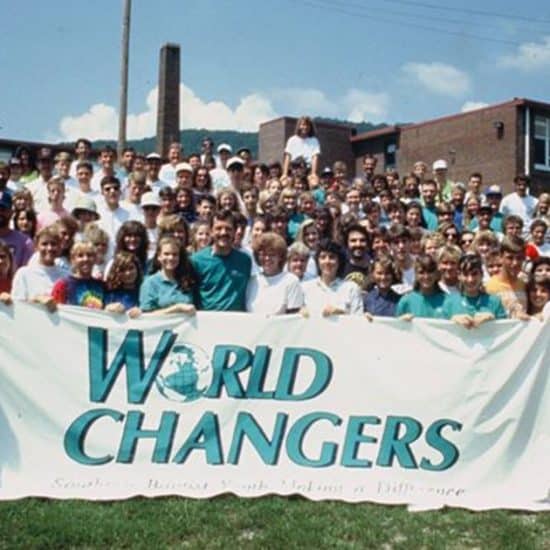ROACH, Mo. — Experts from the Missouri missions community discussed differences between the beginning of the modern missionary movement and its future at “The Future is Bright” senior adult retreat Oct. 1 at Windermere Baptist Conference Center.

Gary Snowden (left), Churchnet missions mobilization team leader, visits with attendees at "The Future is Bright" senior adult retreat at Windermere Baptist Conference Center following a panel discussion about missions in the 21st century.
|
Janet Hill, Windermere’s program director, acted as emcee to the panel discussion that included Mark Struckhoff, director of the Springfield Council of Churches; Tim and Chris See, New Tribes Mission missionaries; Harold Phillips, Cooperative Baptist Fellowship-Heartland coordinator; Gary Snowden, Churchnet missions mobilization team leader; Duane and Marcia Binkley, field personnel for both national CBF and American Baptist Churches-USA.
When the group was asked to describe a possible change in missions paradigm based on Acts 1:8 for the 21st century, Snowden noted, “Missions is here but also around the world…. It is simultaneous…to make sure there are no groups without access to the gospel.”
Hill asked Struckhoff to describe how changes in U.S. demographics affect social services at the local level. Struckhoff pointed out that Springfield is the second least diverse city in the country.
“There is a sense in which post-modernism is a big influence. All people have their own stories and each story is authoritative,” he said. Now there is no longer a “common language,” particularly regarding the gospel.
The panel noted that the approach to short-term missions also is different. “Growing up you prayed for ‘those over there,’” Phillips said. “The challenge is how to pray for those working here.”
When asked to name the biggest change they have seen in the approach to missions, See noted that technology has played a significant role.
His book on technology for missionaries has to be updated more frequently than in the past, he explained. Now, leaders just about anywhere in the world, even in jungle areas, have cell phones and can receive lesson plans electronically.
Snowden believes a shift from cooperative missions has taken place. Many missionaries have “subservient” and “bureaucratic” attitudes about the nationals with whom they work. They have a “we-know-how-to-do-missions” approach and impose ministry programs without consulting the nationals.
But “some groups are moving back to more of a cooperative approach,” he said.
The panelists noted that the involvement of the local church has changed over the years, as well. Some churches have decided they will do only short-term missions as a means to get all members involved, See explained. “But we need both” long- and short-term involvement, he said.
The emergence of the megachurch has impacted local missions, according to Struckhoff. Their involvement in the community sends the message that the megachurch is making an impact and doing a lot of good.
“But it sort of undercuts the unity [of churches working together]…. They can kind of take over in some ways…. That’s why…the collaborative spirit is important in the community,” he said.
“We need deep listening [to the community]… or we will miss opportunities for meaningful service in the community.”
Binkley noted the need for long-term missionaries on the field. He has seen a change in the definition of “short-term” in his years of service. He used to consider a “short-termer” as one who spent about two years overseas.
“Now it’s just a couple of weeks,” he said.
He added that sometimes churches view short-term missions more as a “great” cross-cultural experience, but that after two to three years, members “wonder why the project isn’t done.”
The panelists also discussed the greatest challenges they see in doing missions in the 21st century.
For Snowden, it’s “to continue to get the church to engage” in missions at all. Some congregations remain in the “old paradigm” — to just pray and give. “The advantage of short-term missions is that it can create excitement,” Snowden said.
“The challenge is the giving,” Struckhoff said, particularly as poverty continues to rise in Springfield. Even though the amount of giving has generally risen every year, when expressed as a percentage of the gross national product, “it has been flat for the last 40 years,” he added.
Mobilizing younger generations and more countries closing their borders to missionaries are the challenges Chris See believes the church faces today. “Some traditional doors are closing,” she said.
Phillips called churches to be strategic. “How do you respond to all the needs out there?” he asked.
That is one way he advises individuals and churches to discover God’s passion for them — to find the need the congregation can meet.
See noted that finding passion is different for each individual and church.
Everything “begins with prayer.” God will give wisdom to believers who ask for it, Snowden emphasized. “Passion will follow.”
But Christ-followers must still present the gospel, Chris See said. All missionaries “must go to that…. You’ve gotta present the Word.”



